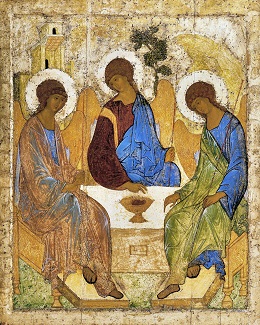Language/Russian/Culture/Visual-Arts-:-Paintings
Early Russian Art[edit | edit source]
If all that comes to mind when you think of Russian art are those little nesting dolls (matryoshka dolls) and onion-domed churches, you're in for a surprise! Russian art is every bit as diverse and interesting as its counterparts around the world.
One of the greatest impacts Russian art has made on world culture developed very early. Around the year 988, Russia converted from a pagan religion to Christianity, and its artists soon became masters of a form known as the icon. No, this doesn't mean the little file folder pictures on your computer desktop. Religious icons are portraits of Jesus Christ, Christian saints, and other major figures. Other icons depict events like the birth of Christ or miracles performed by saints.
Icons are common in Eastern Orthodox Christianity, to which the Russian church belongs, and feature stylized portraits and flattened perspective, as you can see in a work by one of the most important Russian icon painters, Andrei Rublev, who lived circa 1360 - 1430, The Trinity.
Westernization[edit | edit source]
Religious art dominated in Russia for many centuries. Leaders even discouraged the production of secular art. Some artists, like Simon Ushakov, who lived from 1626 to 1686, resisted this, however, and made work influenced by the icon style but depicting non-religious subjects.
Everything changed when Tsar Peter the Great, who lived from 1672 to 1725, began a program of westernizing Russian culture to make it more similar to Europe's. The reigning style in Europe at the time was Neoclassicism, so many Russian works in the 18th and early 19th centuries share its characteristics. Historical, biblical, and Classical (Greek and Roman) subjects were popular among artists like Anton Losenko, who lived from 1737 to 1773. Russian artists like Ivan Nikitin, who lived from 1688 to 1741, and Dmitry Levitsky, who lived from 1735 to 1822, also produced masterful portraits in the academic style, which stressed realistic techniques and the idealization of its subjects. The Russian Academy of Arts, founded in the middle of the 18th century, helped to centralize Russian art and produce artists skilled at producing works that matched the expectations of academic and Neoclassical art.
Nineteenth Century & Realism[edit | edit source]
Artists can be rebellious, so it's no surprise that by the 19th century, Russian artists began to get bored with the strict guidelines and limited subject matter dictated by academic and Neoclassical art. A group of artists known as the Wanderers (Peredvizhniki) produced works depicting more familiar, native Russian subjects rather than ones imitating Western models. Ivan Shishkin, who lived from 1832 to 1898, and Ilya Repin, who lived from 1844 to 1930, were two of its most important artists. Shishkin's Morning in a Pine Forest (1878) shows the realist style that these artists captured.
[[File:B8186a67-c1ac-4de7-adfa-30bbb2422ddd utro v sosnovom lesu.jpg|thumb|Morning in a Pine Forest by Shishkin]
At his core, Repin's art was realist because it depicted scenes related to Russian life and history, such as his famous work showing the violent moment when the 16th-century Tsar Ivan the Terrible murdered his son.
Modernism[edit | edit source]
As the 20th century dawned, Russia underwent major changes, including the 1917 revolution, a civil war, and the founding of the Soviet Union (USSR). Russian art responded to these tumultuous events by becoming more experimental and avant-garde, like other Modernist movements around the world. Some artists, like Wassily Kandinsky, who lived from 1866 to 1944, and Marc Chagall, who lived from 1887 to 1985, worked in both Russian lands and Europe. Chagall produced works in a variety of media that show the influence of folk life and Jewish culture, and used vibrant colors and an imaginative, often dream-like style. Kandinsky produced some of the first significant abstract and non-objective works, freeing art from the need to be realistic or even depict recognizable subjects.
The Futurist movement, which was an artistic movement prevalent in nations like Italy that emphasized modern societal and technological developments, also strongly influenced Russian artists like Alexander Rodchenko, who lived from 1891 to 1956, and Natalia Goncharova, who lived from 1881 to 1962. Russian artists of this movement emphasized boldness of design, angular shapes, and modern themes, as you can see in Rodchenko's famous photomontages, or Goncharova's painting The Cyclist (1913).
Other Lessons[edit | edit source]



